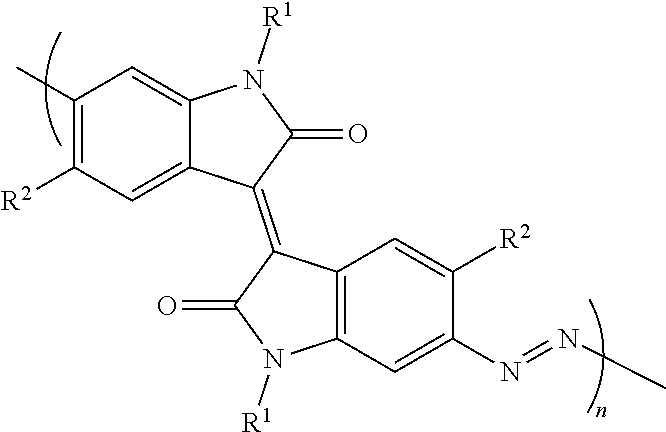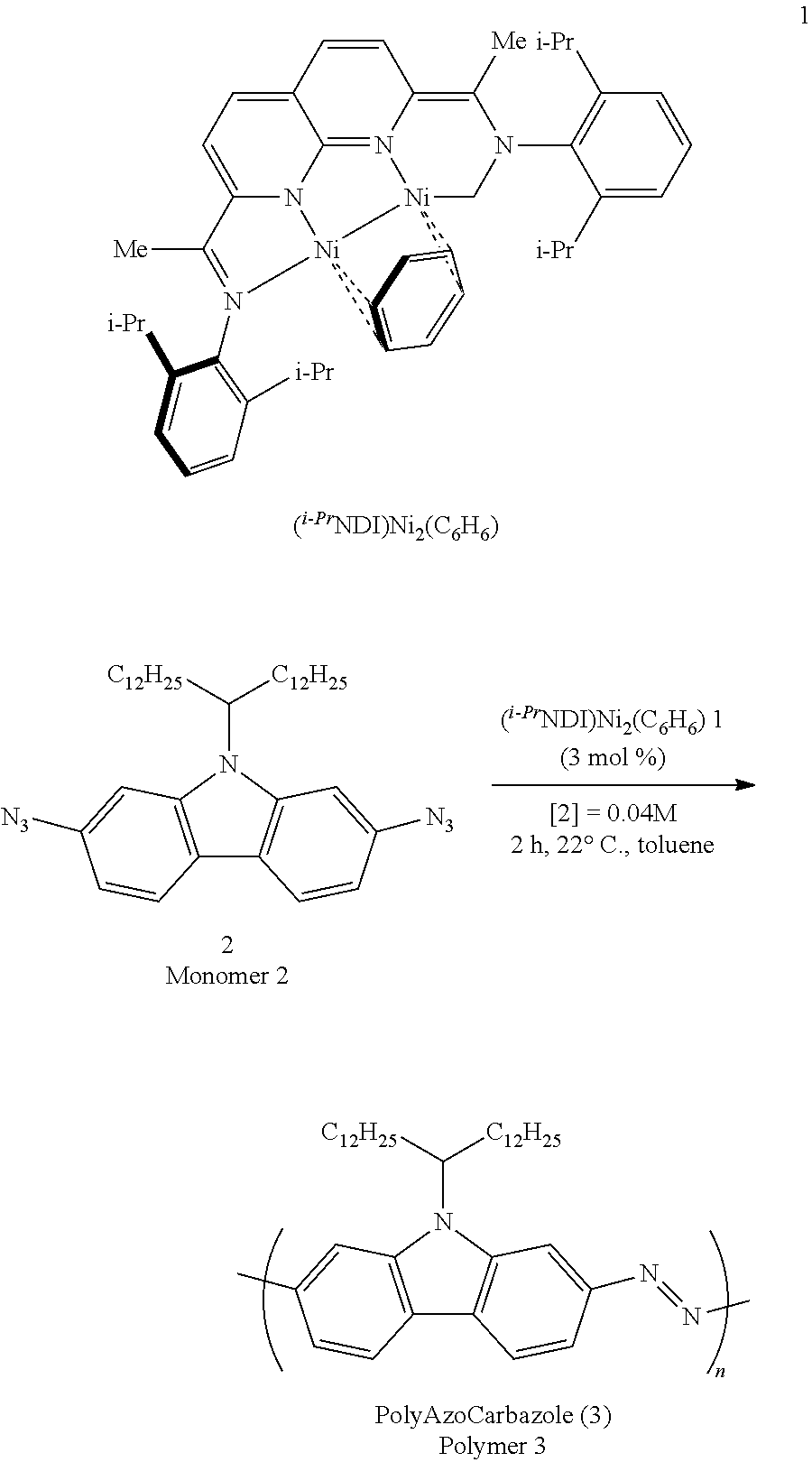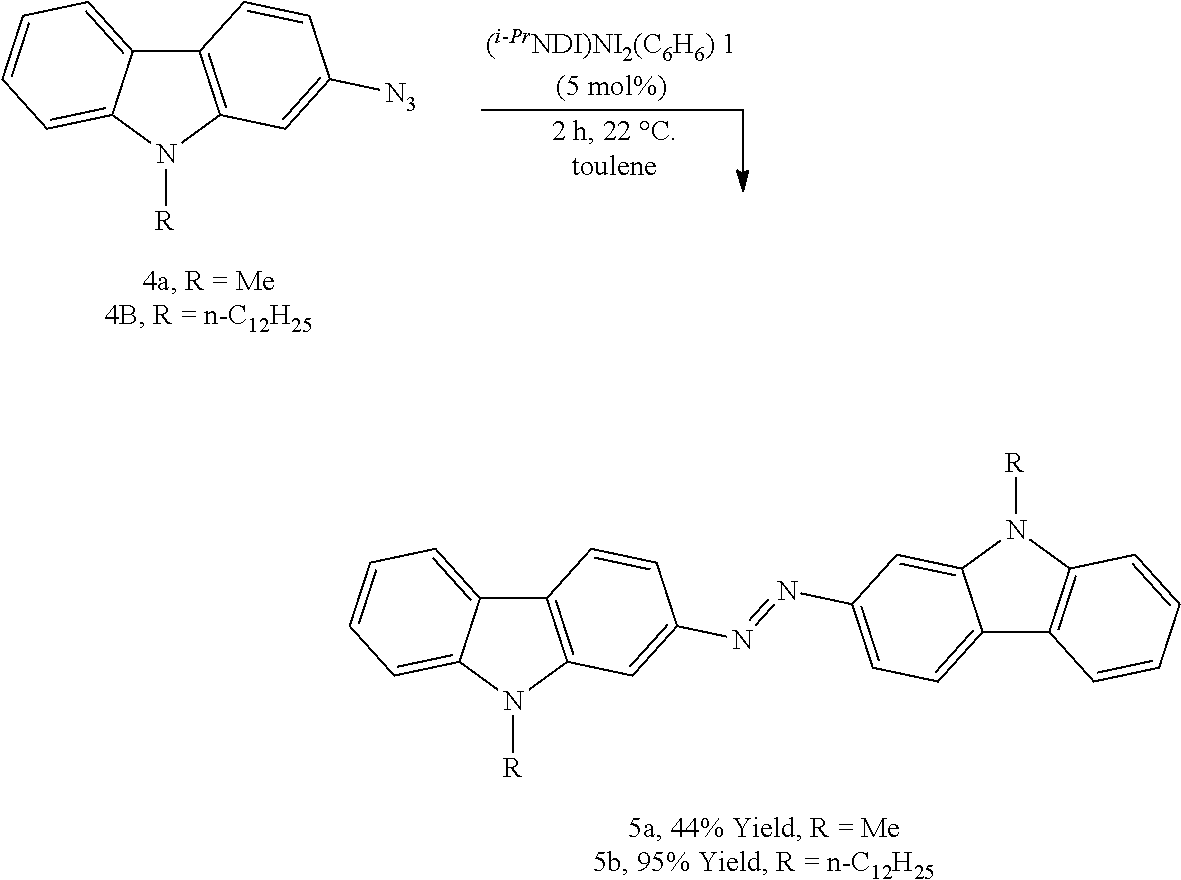Conjugated Azopolymers Made From Aromatic Azides And Methods For Making Same
a technology of conjugated azopolymers and aromatic azides, which is applied in the direction of photovoltaic energy generation, etc., can solve the problems of cross-coupling reactions, low average molecular weight polymers, and negatively affecting optical and electronic performan
- Summary
- Abstract
- Description
- Claims
- Application Information
AI Technical Summary
Benefits of technology
Problems solved by technology
Method used
Image
Examples
example 1
rbazole
[0030]Diazido carbazole (“monomer 2”) was selected as a model substrate for the initial reaction development studies (Table 1). When (i-PrNDI)Ni2(C6H6) (3 mol %) (“catalyst 1”) was added to a toluene solution containing monomer 2, effervescence of N2 was observed, and the solution turned deep red over the course of minutes at room temperature. After 2 hours, crude polymer was precipitated from the reaction mixture by addition of 1:1 MeOH / CH2Cl2. PolyAzoCarbazole (“polymer 3”) is soluble in toluene-d8 at 100° C. and possesses all of the 1H NMR resonances expected for the carbazole repeat unit (aromatic region: 8.47 (s, 2H), 8.16 (d, J=8.4 Hz, 2H), 8.09 (d, J=8.3 Hz, 2H)). ATR-IR analysis of solid samples revealed that nearly all of the azide from the starting material was consumed in the polymerization. However, a small residual stretch at 2106 cm−1 was detectable, indicating that unreacted aryl azides are present in the polymer chain ends. By gel permeation chromatography (“G...
example 2
oindigo
[0036]In order to synthesize the monomer for polymerization, first (E)-6,6′-dibromo-1,1′-di(pentacosan-13-yl)-[3,3′-biindolinylidene]-2,2′-dione was synthesized. 6,6′-dibromoisoindigo (0.42 g, 1.0 mmol, 1.0 equiv) and Cs2CO3 (0.98 g, 3.0 mmol, 3.0 equiv) were added to a reaction flask and sealed. The reaction vessel was sparged 3 times to remove air, thereafter anhydrous N,N-Dimethylformamide (10 mL) was added and the mixture was heated at 70° C. After 30 minutes of heating pentacosan-13-yl 4-methylbenzenesulfonate (1.2 g, 2.2 mmol, 2.2 equiv) dissolved in anhydrous N,N-Dimethylformamide (10 mL) was added and the reaction was allowed to stir for 16 h at 70° C. After cooling to room temperature, the reaction mixture was filtered and the filtrate was concentrated under reduced pressure. The residue was purified by column chromatography (SiO2, hexanes, Rf=0.2). The product was isolated as a deep red solid (0.56 g, 50% yield).
(E)-6,6′-dibromo-1,1′-di(pentacosan-13-yl)-[3,3′-biind...
PUM
| Property | Measurement | Unit |
|---|---|---|
| Mw | aaaaa | aaaaa |
| PDI | aaaaa | aaaaa |
| wavelengths | aaaaa | aaaaa |
Abstract
Description
Claims
Application Information
 Login to View More
Login to View More - R&D
- Intellectual Property
- Life Sciences
- Materials
- Tech Scout
- Unparalleled Data Quality
- Higher Quality Content
- 60% Fewer Hallucinations
Browse by: Latest US Patents, China's latest patents, Technical Efficacy Thesaurus, Application Domain, Technology Topic, Popular Technical Reports.
© 2025 PatSnap. All rights reserved.Legal|Privacy policy|Modern Slavery Act Transparency Statement|Sitemap|About US| Contact US: help@patsnap.com



